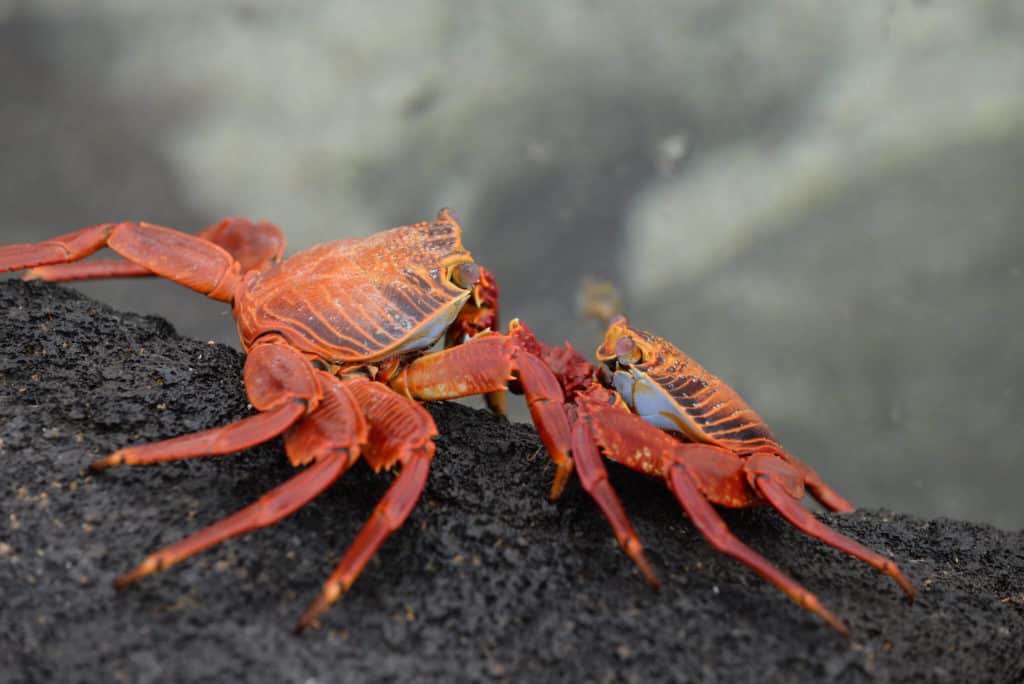Crabs belong to the subphylum Crustacean which is the largest group of marine arthropods. They can be found in many oceans and freshwaters all over the world with over 4500 different species.
These crustaceans are fascinating, they have unique abilities such as being able to walk and run sideways and have 360-degree vision.
In this post, we’re going to take a closer look at the crab’s reproduction process and answer do crabs lay eggs?
Yes, crabs do lay eggs, a lot of them! Female crabs can produce as many as 100,000 eggs, with egg masses having an average of two million eggs but can have up to eight million eggs.
How Do Crabs Reproduce?
In the spring breeding season, crabs typically attract one another by using pheromones. Once they mate, the female crab can hold the sperm until her eggs are ready to be released.
When the eggs are released, the stored sperm flows over them and begins the fertilization process. When this process is complete, the eggs are moved to a spongy mass between their abdominal flap and the body.
The eggs are protected here during the embryo development phase. Females carrying eggs are often given the name “berries”, as they can resemble round berries whilst carrying.
After the development is complete, female crabs release the newly hatched larvae into the water where they become part of the plankton and begin to grow.
Where Do Crabs Lay Eggs?
The largest gathering of crabs on earth happens once a year on Christmas islands. The red crabs there have the instinct to breed, so they commute from the jungle all the way to the ocean.
Each year around 40 million crabs make the journey, but not all of them make it there for a number of reasons from ant attacks to getting squished by traveling cars.
These red crabs 4 kilometers to reach the ocean, which can take them anywhere from between 5 and 7 days.
Some species of crab travel up to 100 miles to reach shallow waters to mate, and once the females hatch their young and molt their exoskeleton they make the long journey back to the deep.
Most female crabs carrying eggs make their way to coasts or estuaries that flow into the sea to release larvae between sunset and midnight during the spring tide.
How Many Eggs Do Crabs Lay?
Some crabs can lay as many as 100,000 eggs at a time, such as the Christmas red crab. Thankfully not all of these eggs will make it to adulthood, as this would mean the crab population would be mindblowing.
Only around one in one million eggs (0.0001%) hatch and make it to adulthood, they have a number of different threats that stop them from making it, such as predators, adverse environmental conditions as well as disease.
A female blue crab can lay a maximum of 8 million eggs in a single mating season! But only one egg is likely to survive from each brood.
Check out this interesting video on crabs laying eggs below:
Do Crabs Eat Their Eggs?
Crabs are opportunistic feeders that will eat anything that comes across their path. They feed on fish, clams, worms, and sometimes their own eggs if needed.
The reason crabs eat their eggs is largely that there are simply so many of them that mothers can get a decent feed from them without harming the overall numbers.
Even once their eggs hatch, hungry mothers will eat their babies if they are struggling to find a meal. Female crabs that recently carried eggs sometimes eat around 25 – 30% of their own larvae.
Crabs don’t form deep connecting bonds with their young like many marine animals, there are just so many of them that even they too become a source of food at times.
Final Thoughts
So, do crabs lay eggs? Absolutely, often up to 100,000 eggs at a time! These fascinating crustaceans mate only once in their lifetimes but can have up to seven broods in a year from a single mate.
Female crabs hold onto the male’s sperm until their eggs are fertilized, allowing them to start the fertilization process when the eggs are ready.
Only around one in one million eggs survive to adulthood, which stops their population from being incredibly high.
If all the eggs from each crab hatched and survived to adulthood there would be millions of crabs running around all over the world.
Hopefully, you’ve enjoyed this post and learned something new today about crabs and their eggs.
Thanks for taking the time to read this post and feel free to stick around to learn more about the wonderful world of crabs.

Hi, I’m George – the founder of MarinePatch. I created this blog as marine wildlife has been my passion for many years. I’ve spent over a decade in the marine wildlife industry and spent years out in the field conducting research. In today’s modern world, an online blog is the best place for me to share my findings and reach as many people as possible to help educate and inspire others. Enjoy your time here and you’re welcome back anytime!

